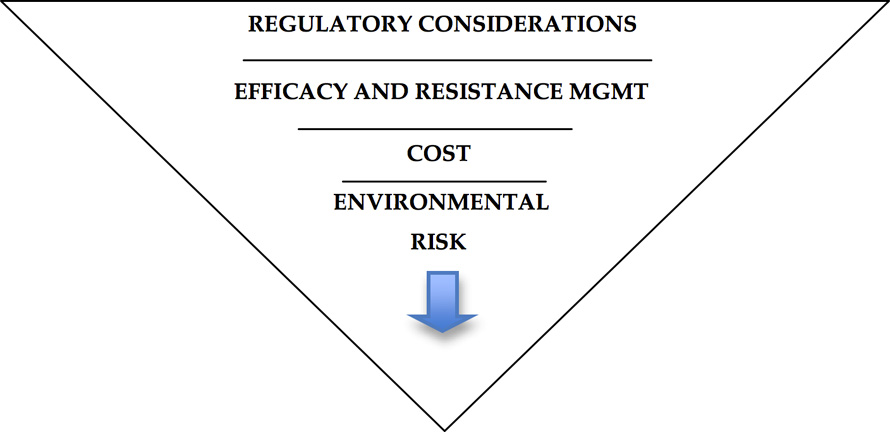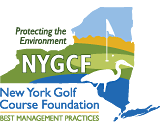When chemical control is needed, several important criteria can be used to select the right pesticide:
- must be registered for use in New York State
- must be properly transported, handled, and stored
- should be effective in treating the pest problem
- the frequency of pesticides usage considered with respect to the possibility of chemical resistance
- costs should be considered
- environmental risk and potential for water quality impacts must be evaluated
 Pesticide selection criteria.
Pesticide selection criteria.Efficacy and Resistance Management
Among the pesticides registered for use in New York, selection should be based on the effectiveness of the product to prevent or treat pest problems. Products that are more effective can often be used at lower rates and fewer applications. The Cornell Guide for Commercial Turfgrass Management published annually by Cornell University lists recommendations for the most effective treatments of pest problems. In addition to these guidelines, manufacturers and trade journals often present research reviewing different products tested. The University of Kentucky provides a special service to the industry by reviewing all research on fungicides and grading the effectiveness of fungicides annually. Read more
Costs
Pesticides are marketed in a variety of forms and packaging. Product selection should not be based on the price per container, as application rates and intervals vary and more effective products with a lower environmental risk can cost less per day of treatment. The real costs of products can be compared using simple tools. The table below shows an example that compares very effective bio-based controls compared to conventional pesticides for the treatment of summer patch.
Cost comparisons of alternative chemical control of dollar spot
| Control | App Rate (oz or fl oz per 1000 ft2) | Cost per 1000 ft2 | Acres Treated | Spray Interval | Cost per Day | FRAC Class | EIQ Quotient | Field Use EIQ |
|---|---|---|---|---|---|---|---|---|
| Daconil | ||||||||
| Banner Maxx | ||||||||
| Emerald | ||||||||
| Civitas | ||||||||
Environmental Risks
The use of pesticides presents certain risks in terms of toxicity to human or other nontarget organisms including soil microbes, insects, birds, animals, and aquatic species. Pesticides can migrate off the target site through the environmental transport process of runoff, leaching, or drift. Understanding both the site and pesticide characteristics and the relationship between these characteristics is the basis for assessing a pesticide’s site-specific vulnerability to transport in the environment.
Pesticide Toxicity
Pesticides may pose varying degrees of risk to humans denoted by the EPA as acute toxicity levels for oral ingestion, dermal sensitivity, inhalation, and eye irritation. Signal words on labels characterize pesticide into four toxicity-based categories to invoke special attention when handling or applying the pesticide.
Signal words by toxicity ratings
|
Toxicity
|
Signal Word
|
|---|---|
| Category I | DANGER |
| Category II | WARNING |
| Category III | CAUTION |
| Category IV | None required |
Pesticide labels also stipulate proper personal protective equipment (PPE) to be worn when handling or applying pesticides. In addition, instructions on the label specify proper procedures in case of accidents or emergencies to prevent exposure. Not as much is known about chronic toxicity due to prolonged exposure to a pesticide as is known about acute toxicity. Some pesticides are known to accumulate over time, although the risks of such accumulation have not been fully identified.
The Pesticide Action Network has compiled a pesticide database that identifies pesticides with known or suspected toxicity. Appendix C provides human health and aquatic toxicity risk ratings for pesticides registered for use in New York State.
For more information:
- PAN Pesticide Database: http://www.pesticideinfo.org
- Pesticide Properties Database (PPDB), pesticide physicochemical, toxicological, ecotoxicological and other related data: http://agrochemicals.iupac.org
Pesticide Characteristics
The fate of a pesticide applied to turf is determined by the soil characteristics, environmental conditions, and the chemical properties of the pesticide. These factors can be used to help recognize conditions and select pesticides that can help minimize the risk of ground and surface water contamination through leaching, runoff, or drift.
Information for pesticides approved for use in New York State are summarized in Appendix C and includes the following information: rate ranges, Field Use EIQ ranges, Chemical Class, Aquatic Toxicity, Solubility, Soil Adsorption (Koc), half life, GUS values, and WIN PST ratings for sand greens. The tables provide reference tools to select pesticides based on their environmental fate and toxicity. A summary of chemical and physical property threshold values indicating the potential for groundwater contamination is provided in the table below.
Threshold values indicating potential for groundwater contamination by pesticides. Source: U.S. Environmental Protection Agency, 1986, Pesticides in Groundwater
|
Chemical or Physical Property
|
Threshold Value
|
|---|---|
| Water solubility | Greater than 30 ppm |
| Henry’s Law Constant | Less than lO-2 atm to m-3 mol |
| Kd | less than 5, usually less than 1 or 2 |
| Koc | less than 300 to 500 |
| Hydrolysis half-life | more than 25 weeks |
| Photolysis half-life | more than 1 week |
| Field dissipation half-life | more than three weeks |
Soil
Soil texture is based on the proportion of sand, silt, and clay. Soils with larger particle sizes have higher aeration (macropore) porosity and greater risk of leaching. Soil surveys classify soil type and texture into four hydrologic groups according to the rate of water infiltration when the soils are not protected by vegetation, are thoroughly wet, and receive precipitation for a long period. The NRCS Soil Survey defines four hydrologic soil groups that vary with respect to leaching and runoff potential.
Leaching and runoff potential by soil group
| Soil Group |
Description
|
|---|---|
| Soils having a high infiltration rate (low runoff potential) when thoroughly wet. These consist mainly of deep, well drained to excessively drained sands or gravelly sands. These soils have a high rate of water transmission. | |
| Soils having a moderate infiltration rate when thoroughly wet. These consist chiefly of moderately deep or deep, moderately well drained or well-drained soils that have moderately fine texture to moderately coarse texture. These soils have a moderate rate of water transmission. | |
| Soils having a slow infiltration rate when thoroughly wet. These consist chiefly of soils having a layer that impedes the downward movement of water or soils of moderately fine texture or fine texture. These soils have a slow rate of water transmission. | |
| Soils having a very slow infiltration rate (high runoff potential) when thoroughly wet. These consist chiefly of clays that have a high shrink-swell potential, soils that have a high water table, soils that have a clay pan or clay layer at or near the surface, and soils that are shallow over nearly impervious material. These soils have a very slow rate of water transmission. |
Pesticide Persistence
Once applied, pesticides break down in the environment through a number of processes: exposure to light (photodegradation), chemical reactions in the soil, and the action of soil microbes or other organisms (biodegradation). Environmental conditions such as temperature, moisture, and pH also affect the rate of pesticide degradation. The rate of degradation is expressed in terms of half-life, which is the number of days required for half the concentration of a pesticide to breakdown. Persistent pesticides, those with a half-life greater than 21 days, pose a threat to water quality.
Solubility
Pesticide chemical properties include a measure of the chemicals cold water solubility, often expressed as grams per liter (g/L), milligrams per liter (mg/L), or parts per million (ppm). A pesticide with a solubility of less than 30 ppm (mg/L) is considered to have a low potential risk to ground and surface water contamination.
Soil Adsorption (Koc)
Once in the soil, pesticides vary in how tightly they are adsorbed to soil particles. Chemical mobility in soil is determined by the ratio of the pesticide’s solid and aqueous phases, KD, in the soil. In a solid phase, the pesticide can bind to soil particles and organic matter. In the aqueous phase, the pesticide dissolves in water. The KD factor varies by soil type. Soil scientists normalize the values, calculating a new coefficient, Koc that accounts for soil organic matter content. The higher the Koc value the greater the bond between the soil and the pesticide. Pesticides with a Koc less than 300-500 are considered a risk to ground water quality, as they tend to dissolve and move with water. The Koc is not well correlated in high clay soils. In these cases, KD is used to evaluate soil mobility.
Groundwater Ubiquity Score
The Groundwater Ubiquity Score (GUS) was developed to model persistence and soil adsorption factors to provide a method to determine the relative risk of leaching. The model was validated by comparing actual leaching data with predicted risks. Pesticides with GUS values greater than 2.8 have high risk of leaching. Pesticides with GUS values below 1.8 are considered to have a low risk of leaching. GUS values for pesticides approved for use in New York have been charted to identify the “leachers” from the “non-leachers”. These GUS values assess risk based on the chemical properties and do not account for soil conditions. Soils with high infiltration rates or sites with excessive slope may be more prone to leaching and runoff. Nonetheless, GUS values provide a tool to help turf managers select chemicals with the lowest GUS value.
Volatility
Some pesticides volatilize readily. Volatility is influenced by environmental conditions, such as temperature, relative humidity, and air movement. High temperatures and low humidity increase evaporation rate. The level of a pesticide’s volatility may be indicated on the label.
